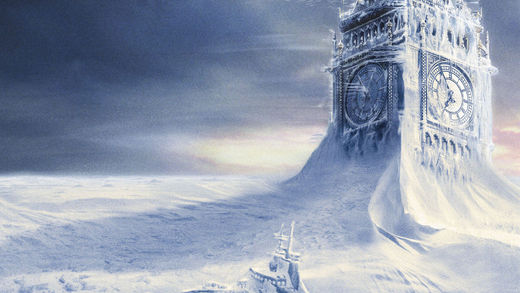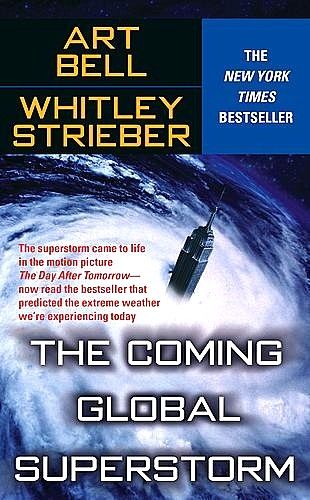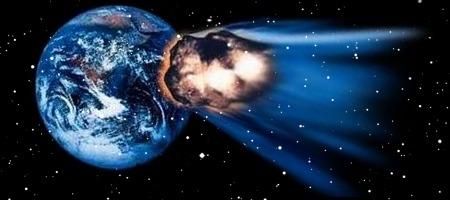The Decade of Millenniumitis
During the last decade, the prospect of end-times catastrophes in the year 2000 plagued many with fear about an uncertain future. Yet, there was a tangible public concern that the year 2000 would bring disaster.
This fostered a consensus of fear that was aptly coined "millenniumitis" by the media and this social event was focused on a set date. As we came closer our fears escalated at a geometric rate.
In the midst of all this came books like Superstorm, which offered a loosely structured, populist speculation that relied more on the public notoriety of the authors for credibility than upon quality research and organization. Nonetheless, the central premise of Superstorm still remains a valid point of discussion for those interested in the process view of catastrophe, as opposed to those who prefer the populist event-driven view.
The Selling of Disaster
Catastrophic events are easy to sell, and all catastrophic charlatans use the same modus operandi wherein they:
- Grab your attention with a scary possibility.
- Give you a taste of their unique and insightful knowledge.
- Tell you they are the only ones who really understand the problem.
- Instruct you where to send the money and how much.
- A Y2K bug catastrophe. It didn't happen.
- Armageddon. It didn't happen.
- A rogue asteroid impact. It didn't happen.
- A hurricane that would level Florida. It didn't happen.
- Some said, "I've been cheated. I was promised a catastrophe, I got ready for it, I waited for it, I worried about it and you didn't deliver! By God, I paid for a catastrophe and you cheated me. I want heads to roll!"
- Others waited till midnight to walk out to their trash bins so their neighbors wouldn't see them throwing away their pricey hard cover predication books.
- A few said, "thank you God. Thank you so very much", as they kissed their children good night."
Indeed, the death of millenniumitis was and remains a true blessing!
Still the same, the saddest part about the death of millenniumitis was that it was cloaked in a burial robe of prudent reason and vigilance.
This is unfortunate because the processes of catastrophe are still at work and as dangerous as ever.
Unexpected Disasters
The phrase "history repeats itself" is every bit as ingrained in the public mind as phrase, "the check is in the mail." Yet, when it comes to catastrophes we're often caught completely off-guard. Why?
In terms of catastrophes, history usually repeats itself because of our myopic focus on events as opposed to processes. This is because we tend to identify catastrophic processes in terms of their final failure events, such as:
- Titanic, April 14, 1911
- Battleship Arizona, December 7, 1941
- Space Shuttle Challenger, January 28, 1986
What these unrelated disasters have in common is that they were all the culminating event of a process, where an unbroken chain of otherwise unremarkable failures eventually resulted in a sudden and catastrophic collapse of an entire system.
With this in mind, let's examine a few samples of the unbroken catastrophic event chains we now call, Titanic, Arizona and Challenger.
Titanic, April 14, 1912: The doomed passengers of Titanic first met their deaths when ship's owners used an outdated law to reduce the number of lifeboats over the many protests of the ship's designer.
The passengers again met their deaths when the Captain of the Titanic knowingly ignored multiple iceberg warnings and ordered the ship to its maximum speed at night. Even though his ship had left port without enough binoculars for the forward lookouts. Then, he handed over command of the vessel to a junior officer on that fateful night, and the rest is history.
Comment: There's actually a lot more to the chain of events that led to the sinking of the Titanic than is recorded in official history:
Was the Titanic deliberately sunk by JP Morgan?
Battleship Arizona, December 7, 1941: In the early 1930's, General Billy Mitchell demonstrated that dive-bombers could sink any battleship. American military leaders clung to their love of capital ships and ignored what their eyes told them, but not so with the more astute Japanese military leaders who intently observed the very same demonstration.
Had American military leaders taken Mitchell's warnings to heart, they would have would have increased the amount of armor on the Arizona's decks, and employed a more effective air defense.
Space Shuttle Challenger, January 28, 1986: Despite the repeated warnings of a top Thiokol engineer, NASA managers launched the shuttle with ice-encased boosters. This disaster was the direct result of an agency that had traded safety for political gain.
Another thing these catastrophic failures have in common is that they are remembered in terms of the final catastrophic event because of its tragic loss of life. The warnings of the knowledgeable few, the harbingers of catastrophe, were ignored then and now appear in an occasional footnote.
When history repeats itself, the first thing to go are the footnotes.
Harbingers of Catastrophe
For the purpose of this article, a harbinger is someone who can identify an unbroken chain of unremarkable failures and then look far enough into the future to see that unless the chain is broken; it will eventually result in a catastrophic failure, and who selflessly tries to warn those in danger. The perfect harbinger is a simple canary.
In earlier days, coal miners would take canaries down into the mines with them. If the canary (with its more sensitive respiratory system) died, the miners knew they were in danger and would attempt to evacuate the mine. Harbingers are mankind's canaries in the coalmine.
Selfless harbingers are just as vital to our continued existence as the canary was to the coal miner, and modern day harbingers come in many forms such as:
- Independent scientists who continue to warn us that our planet is changing for the worse and that we will suffer for it.
- Self-taught observers who track and write about failure chains that could lead to catastrophic finales.
- Individuals who choose to invest the time to become self-informed, and who discuss their findings with family, friends and associates.
- Pretenders typically point to selective elements within a failure chain as a way to validate a totally unrelated belief system.
- Charlatans capitalize on a public fears and offer solutions for a price.
- Self-serving debunkers are quickly identified by their rhetoric and manner. When they see public interest growing in the announcement of a harbinger, they attack the harbinger and the information presented with personal attacks, ridicule, sloppy research, innuendo and falsehoods.
What pretenders, charlatans and self-serving debunkers all have in common is that they deflect the spotlight of public attention away from the selfless warnings of well-intentioned harbingers, and onto themselves.
In essence, they attract those that do not want to be concerned by legitimate observations, and in turn are compensated through various rewards aimed at their own self-interests.
But the real tragedy of pretenders, charlatans and self-serving debunkers is they perpetuate the worst reasons why history repeats: Ego gratification, unbridled greed, and self-aggrandizement.
But Are The Harbingers Always Right?
In the beginning of this article, I discussed the book, The Coming Global Superstorm by Art Bell, Whitley Strieber, and why it had made its way to publisher's clearance sale with a whopping 70% discount off the original publisher's price. Is this because Bell and Strieber were wrong?
That is hard to say, but had they not been rushing to market to capitalize on the millenniumitis phenomena, they could have written a much better book.
Still the same, Bell and Strieber did present an intriguing idea: A sudden flip-flop of nature could result in violent and freezing weather worldwide.
For many, the idea of such a huge and sudden flip-flop appears illogical, especially when you've been taught that nature works at a slow and steady Darwinian pace.
However, what Bell and Strieber failed to establish in their book is that sudden massive flip-flops are a valid phenomenon nature, and as a matter of fact we are seeing one now.
Today, NASA tells us that our sun has just flip-flopped!
NASA, February 15, 2001If the sun can flip its magnetic poles, then who is to say that Bell and Strieber have not hit upon something that could actually explain why scientists continue to find flash frozen prehistoric Wooly Mammoths under the Siberian tundra with fresh, undigested grasses in their stomachs.
The Sun Does a Flip
NASA scientists who monitor the Sun say that our star's awesome magnetic field is flipping -- a sure sign that solar maximum is here.
You can't tell by looking, but scientists say the Sun has just undergone an important change. Our star's magnetic field has flipped.
The Sun's magnetic north pole, which was in the northern hemisphere just a few months ago, now points south. It's a topsy-turvy situation, but not an unexpected one.
"This always happens around the time of solar maximum," says David Hathaway, a solar physicist at the Marshall Space Flight Center. "The magnetic poles exchange places at the peak of the sunspot cycle. In fact, it's a good indication that Solar Max is really here."
This flip-flop of the sun's magnetic poles is not just an idle curiosity either. This current solar maximum has been late in coming, and the highest activity levels ever recorded have preceded it.
While the folks at NASA are downplaying this with what essentially reads like "gee whiz, isn't this interesting", thousands of acres of Florida swamp lands are burning out of control because fire-fighting equipment cannot traverse the mud and water of the swamps.
AP, February 19, 2001What is wrong with this picture? Thousands of acres of wet, muddy and humid swamplands are burning out of control. But that is not the half of it.
Fla. Firefighters Battle Wildfire
POLK CITY, Fla. - Firefighters battled early Monday to control a 9,000-acre wildfire in a dry swampy area in central Florida.
The blaze has closed a 10-mile section of Interstate 4 and forced the evacuation of about 30 homes near here. No injuries were reported and no houses were damaged.
The wind-driven fire in the Green Swamp grew from 2,000 acres Saturday night and jumped I-4, a heavily traveled route between Tampa and Orlando. It was not known when I-4 between U.S. Highway 27 and State Road 33 would reopen.
A total of 1,230 fires have scorched 83,150 acres from the beginning of the fire season Jan. 1 through Saturday, according to the Florida Division of Forestry.
Fire officials say the drought and recent freezes mean conditions for igniting fires are worse than in 1998, when blazes burned 500,000 acres across the state.
"I'm afraid it's going to be a long season," said J.P. Greene, aviation manager with the forestry division in Tallahassee.
NASA has assured that our sun has finally reached the peak of its current solar maximum, but what they fail to mention is that the solar maximums are also accompanied by elevated levels of impact events, as was demonstrated with the 1908 Tunguska and 1930 Amazon basin impact events. Both of these impact events devastated huge tracts of land, and both occurred during a solar maximum such as the one now occurring at this very moment.
So why hasn't NASA said anything about this?
Between a Rock and a Hard Place
When it comes to being honest with its people, the American government is between a rock and a hard place.
Conspiracy theorists would have you believe they are withholding information for some clandestine purpose. While we can all debate these claims until the cows come home, a more reasonable explanation can be found in the way the general public views catastrophe.
The general public abhors fear, and if they must face it they demand absolutes (even though they'll admit the only absolutes are death and taxes.)
When they have to prepare for possible catastrophe because a well-intentioned governmental agency takes upon its shoulders the mantle of being a harbinger, the catastrophe is expected and the government is expected to do something about it.
Announcing predications of a possible catastrophe can be a terribly punitive process for our government officials, because our media is quick to kill the messenger when the catastrophe fails to materialize.
We have become a country of people who have abdicated the control over our own lives and when we are reminded of that by an unfilled predication of catastrophe we want heads to roll. Consequently, if the harbinger is wrong, it means his or her career, if not part or all of the funding for his organization.
If your career was on the line and you were not dealing with an absolute possibility, would there be any real difference between 3 days of panic and 3 weeks of panic?
The odd thing is that Americans used to be more self-reliant. Many of us used to have root cellars and victory gardens. We canned our food and made sure that we always had enough on hand to make it through a disaster. Why? Because we recognized that the unexpected is the supreme absolute in life and that to survive required planning, diligence, and above all else, self-reliance.
Are We Doing This To Ourselves?
Capitalism is historically the best way to manage scarce resources, but it also has a narcotic effect that increases on par with our wealth, and it dulls our ability to anticipate and manage crisis.
But as the saying goes, "history repeats itself" and as archaeologists dig up the remains of one ancient culture after another they often see the same recurring commonalities:
- The society progressed to a relatively high state of technology.
- Knowledge and technology became the private domains of a pampered few.
- In its quest for greater wealth, comfort and prestige, the society sacrificed its harmony with the surrounding environment.
- The collapse of the society was often sudden if not catastrophic, and in many instances wholly predictable.
Nonetheless, if we look to blame o ur government, then we will assure ourselves of a bright future as archaeological oddities for future archaeologists, who most likely will have little if anything in common with us.
When will mankind be able to break the cycle of repetitious history?
When mankind learns that the key to survival is the harmonious and peaceful coexistence between our environment and each of us. When that happens, we will have the peace of mind to be mindful of processes, as opposed to waiting for events. Beauty queens have been telling us this for years (all I want is world peace), so at least we know the material is popular with audiences. You never know, there could be something there!
Real Change Begins With the Individual
The most significant difference between our modern society and those who have come before us, is our personal access to knowledge and the unparalleled ease with which we can access and share knowledge via the World Wide Web.
Regardless of whether you agree or disagree with all or part of this article, the fact that you the reader and I the author are freely conducting this digital dialogue is the real difference between our forefathers and us.
In this new instant digital world, the richly lavished high priests of ancient times no longer control the knowledge we now commonly share. Rather, much of the knowledge mankind now possesses is freely available to us, and in sufficient quantities for us to become self-informed and self-reliant enough to ensure our own survival.
Sure, the effort of such a personal quest is unpleasant at first, but over time that changes. The biggest reason for this change is that as you become a self-informed individual, your view of catastrophe evolves. You move from an erratic event-driven viewpoint where information is controlled by a sacred few, to a process-driven viewpoint that give you a more realistic idea of what is coming, and how to best prepare for it.
Once you've adopted a process-driven viewpoint, you will come to the inescapable conclusion that everything happens for a reason and that the universe is unfolding as it should.
Armed with this new self-informed reliance, you will find comfort in ability to cope with the future and you will gain a new sense of appreciation for the true value and beauty of life and the world around us.
The Future
The road ahead for mankind is paved with fear and death for the foreseeable future. Our planet is changing, and wars and the rumors of wars abound as rogue states arm themselves with weapons of mass destruction. It is a frightening prospect, but we've been there before and survived.
During the WWII blitz, Londoners were targeted by buzz bombs and missiles, which rained death with unpredictable results. In the midst of this uncertain suffering and death, public interest in classic literature, plays, opera and musical performances reached its highest level for century.
No matter what comes, we must believe that there will be enough of us who will find a new purpose in life, as well as a deeper appreciation for mankind's noble virtues.
If, this time, we finally break the repetitious cycle of history that takes our societies through birth, existence and destruction, it will only happen after we finally manage to build an unswerving worldwide commitment to harmony between our peoples, our environment and ourselves.






Article